by Ian Skellern
Welcome to the 2019 edition of Quill & Pad’s early Grand Prix d’Horlogerie de Genève predictions in which the team picks favorites and explains why.
The panelists are:
Ian Skellern (IS), co-founder and technical director
Joshua Munchow (JM), resident nerd writer
Martin Green (MG), resident gentleman
Sean Li (SL), editorial director of Blackbird Watch Manual
Tim Mosso (TM), watch specialist and media director of pre-owned watch retailer Watchbox
Note: as jury members, editor-in-chief Elizabeth Doerr and resident collector GaryG do not take part in these early predictions.
The GPHG foundation describes the Chronometry category for watches entered as “mechanical watches comprising at least one tourbillon and/or a special escapement and/or another development improving chronometry (precision timekeeping). Additional indications and/or complications are admissible.”
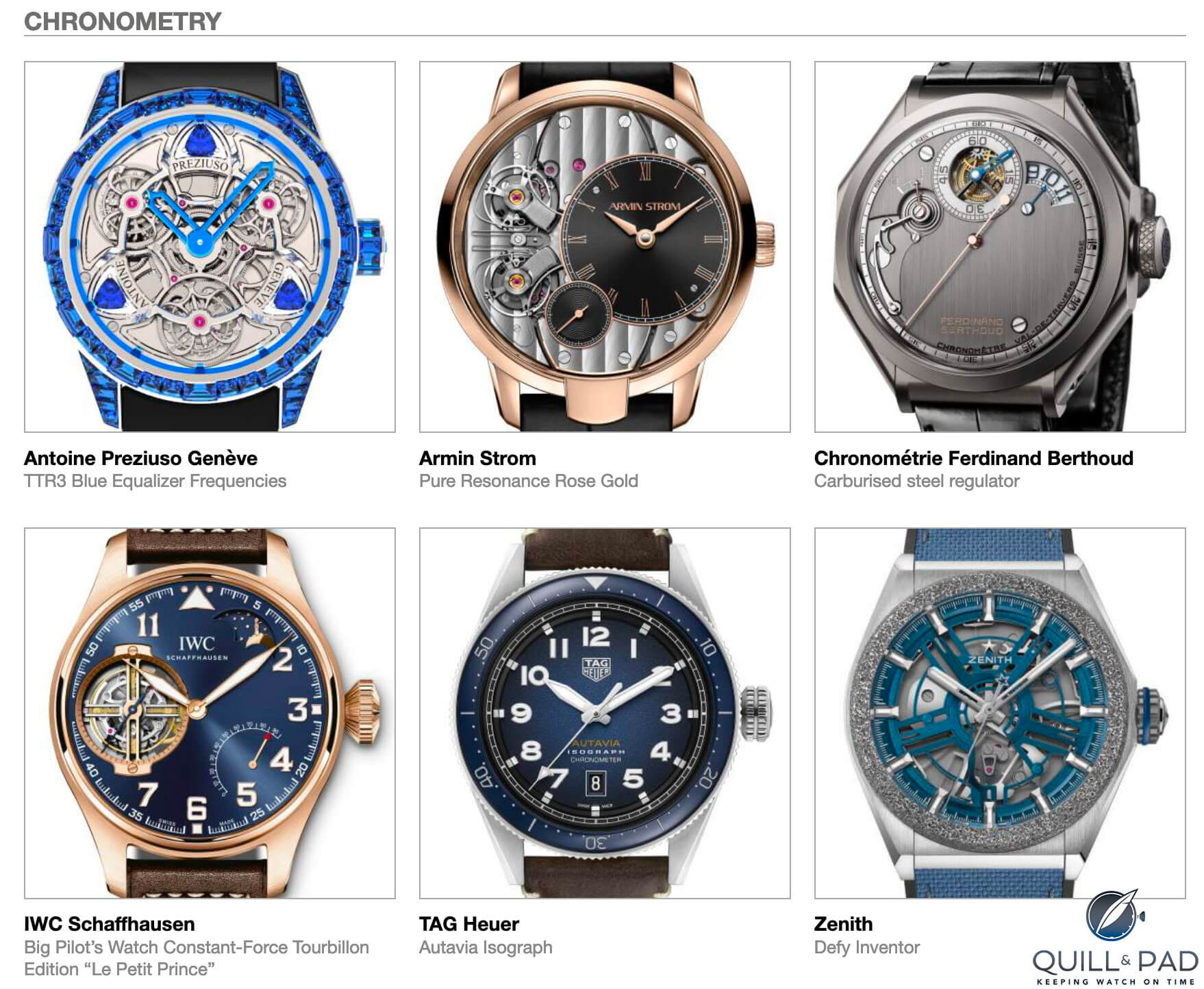
Shortlisted Chronometry watches in the 2019 GPHG (from top left): Antoine Preziuso TTR3 Blue Equalizer Frequencies, Armin Strom Pure Resonance Rose Gold, Chronométrie Ferdinand Berthoud Carburized Steel Regulator, IWC Big Pilot’s Watch Constant-Force Tourbillon Edition Le Petit Prince, TAG Heuer Autavia Isograph, and Zenith Defy Inventor
MG: Here is a category that I am torn about. To me, the winner in this category should be decided by an observatory competition. Will a vintage fusée and chain outperform a triple tourbillon, or will the power of resonance prevail? Or will the new technologies introduced by TAG Heuer and Zenith prove to be superior? I have no idea, so I actually don’t feel qualified to call out a winner.
IS: I have no idea how the jury will vote for the best Chronometry watch 2019 from the six pre-selected here either, Martin. And, if precision is all the category is about, it really should be judged by an observatory or C.O.S.C. trial. The fact that the watches are judged by a jury of humans rather than atomic clocks implies to me that the GPHG wants us to look at the watches as a whole instead of just looking for the smallest number on a printout. That said, this is an incredibly strong line up of wristwatches; all could win depending on the jury’s personal preferences. I’d love to cop out and call it a two-way tie for first place. But I won’t.
JM: I’m going to start right off by saying this category turns me into a bit of a precision Nazi (and I don’t like Nazis) because if we are going to talk about efforts to improve chronometry, and you don’t talk about what your system can do in hard numbers then it’s all theory and fluff. If you design something groundbreaking to improve chronometric performance and you can’t determine if it even meets chronometer standards, well it may not deserve a chronometry trophy.
Granted, you just developed something that may work as well as a previous great invention and that is definitely nothing to scoff at, but the point of a chronometry category is to highlight actual advancements. If you can’t even share the rate statistics, then chances are a win in this category is unlikely in my eyes.
SL: And here we reach the category that tends to puzzle the layperson and the average salesperson in a watch shop (didn’t we just talk about the chronographs?). But seriously, a very interesting technical topic, although I would’ve liked to see some proof in the pudding. Perhaps the GPHG would consider putting the watches entered here through some chronometric tests?
TM: This category is packed with legitimate technical achievements, but it’s starved for truly new ideas. The Zenith, Ferdinand Berthoud, Antoine Preziuso, Armin Strom, and IWC are based on existing platforms and even previous GPHG award winners.
Antoine Preziuso Genève TTR3 Blue Equalizer Frequencies
SL: I’d really like to rate this one higher, but fundamentally it’s a watch that already won the Innovation Prize at the 2015 GPHG when I was on the jury. I’ll recognize that the technical achievement is, still, impressive, but with all due respect to Antoine and his son Florian, I would prefer to see something different, particularly in this highly technical category.
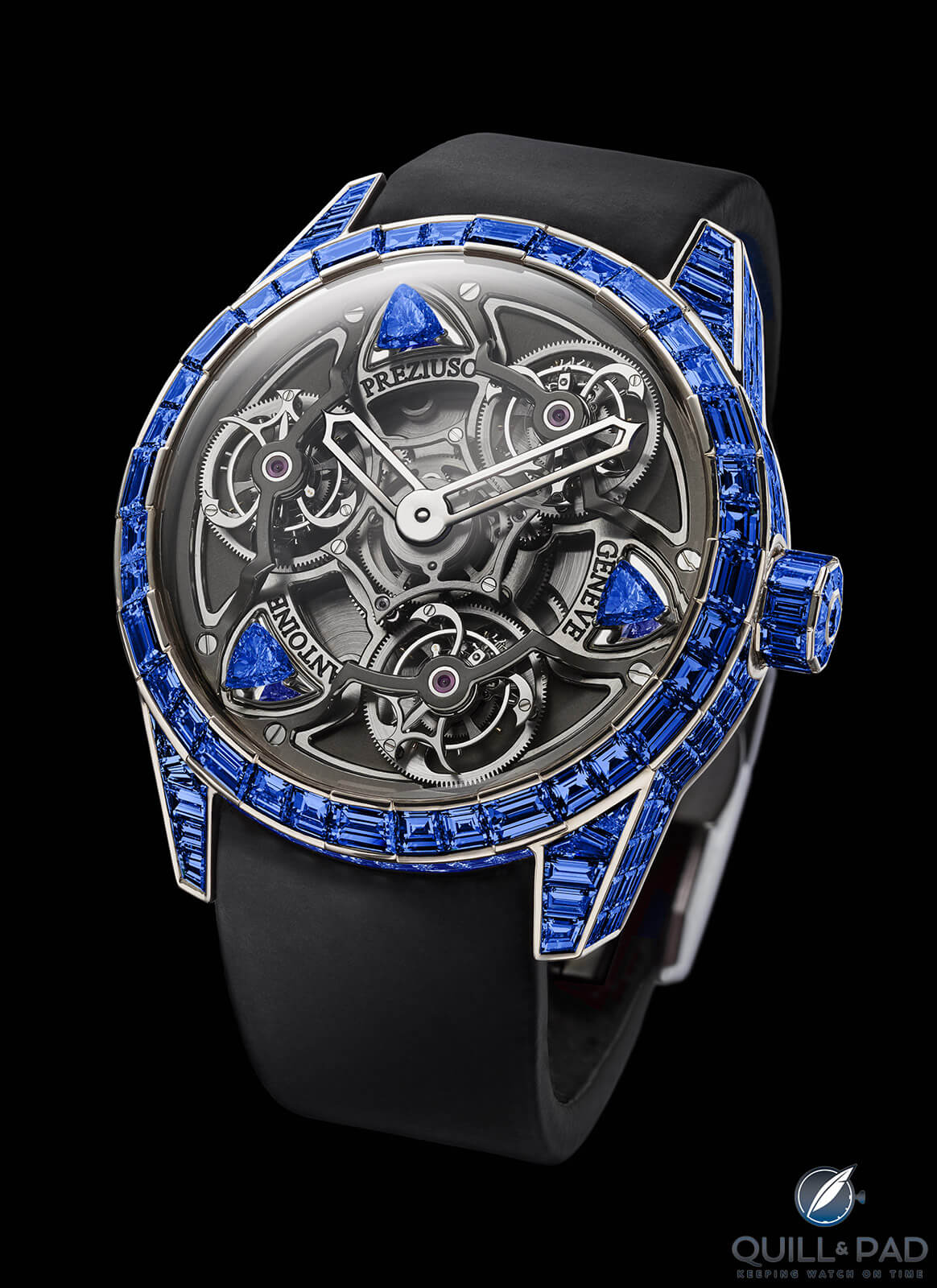
Antoine Preziuso Genève TTR3 Blue Equalizer Frequencies
TM: Antoine Preziuso and company know how to make a stunning watch. At every level from the brand’s mass-produced options to the Olympian Harry Winston Opus 2, Preziuso watches are head-turners. The 2015 Tourbillon of Tourbillons lends most of its shape and all of its running gear to the TTR3 Blue Equalizer Frequencies. That means the watch is a technical masterpiece, but it’s not new in any sense material to this selection. The blue sapphires are gorgeous, and this could have been a competitive pre-selection for the Jewelry title.
JM: I can love a watch so very much and think it is not even close to being right for a category. I love the stone settings on this watch (especially those trillion sapphires; I love trillion cuts), and the mechanism has always been an awesome example of watchmaking ingenuity and craftsmanship. But it has no second hand, and with three balances there is no reasonable way to know what the effective rate of this watch is as far as I know.
The only way to find out might be to record all three balances with a high-speed camera to measure the rate of each and then assume that as a baseline average, which is definitely not how you should test the rate on a watch. I love this watch, I would want this watch, but I can’t say that it effectively demonstrates improved chronometry in any way besides in theory. Those sapphires, though!
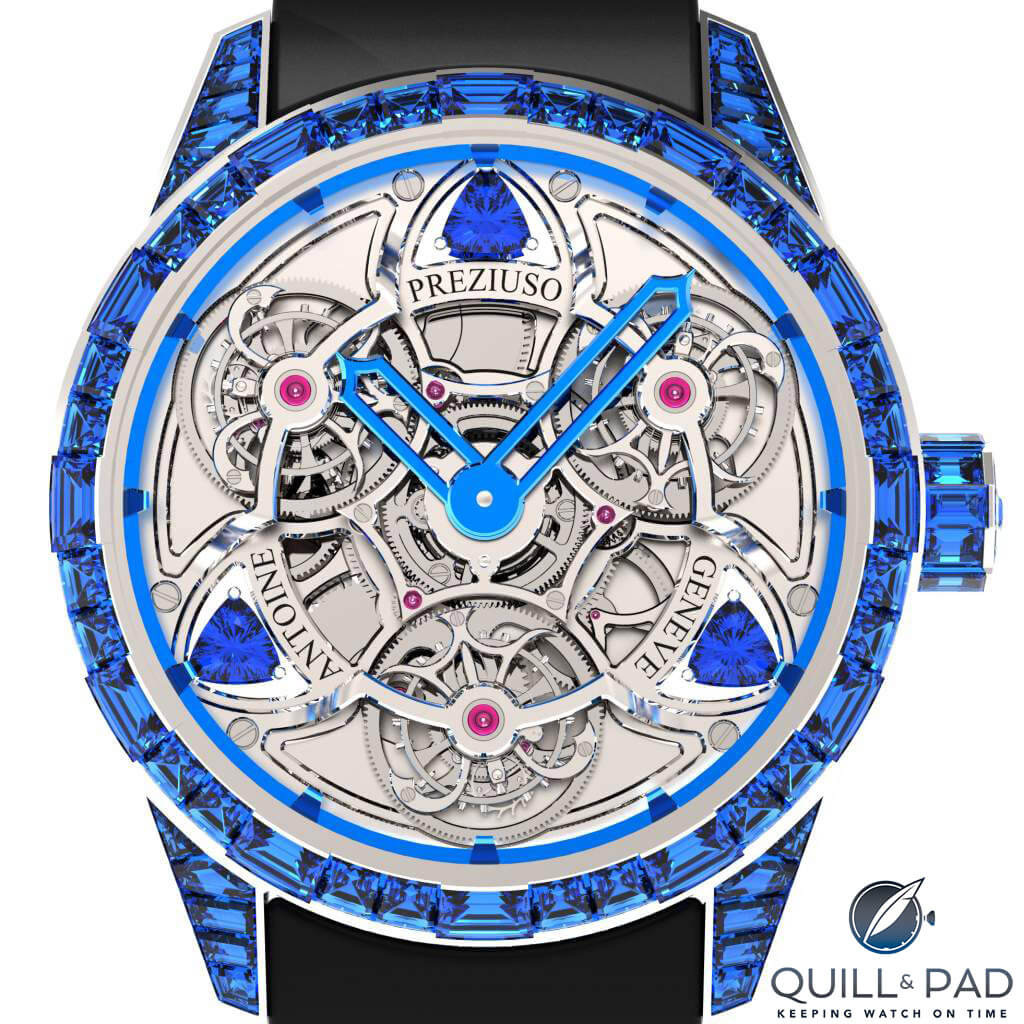
Antoine Preziuso Genève TTR3 Blue Equalizer Frequencies
IS: Antoine Preziuso’s Tourbillon of Tourbillons triple tourbillon is both a horological and visual tour de force, and this TTR3 Blue Equalizer Frequencies version is absolutely spectacular. I still can’t get my head around understanding how the differential — developed by Antoine’s son, Florian — works with three inputs, but it does.
However, although the tourbillons synchronize with resonance to provide a more stable rate of the balances, I’ve not heard any claims that the watch offers exceptional precision. While I do think it well deserves pre-selection here, it might have been better suited to the Men’s Complication or Mechanical Exception categories.
Further reading:
Antoine Preziuso Tourbillon Of Tourbillons: Fractals Meet ‘Inception’
Reflections On The 2015 Grand Prix d’Horlogerie de Genève
For more information, please visit gphg.org/horlogerie/en/watches/ttr3-blue-equalizer-frequencies.
Quick Facts Antoine Preziuso Genève TTR3 Blue Equalizer Frequencies
Case: 47 x 14 mm, white gold set with 233 sapphires (more than 24 ct)
Movement: manually wound Caliber AFP-TTR-3X with three one-minute tourbillons comprising a fourth ten-minute tourbillon carriage via planetary differential, 48-hour power reserve, 3 balances beating at 3 Hz/21,600 vph, 570 components, 3 integrated trillion sapphires (0.76 ct)
Functions: hours, minutes
Limitation: unique piece
Price: 1,200,000 Swiss francs
Armin Strom Pure Resonance Rose Gold
SL: I’ve had quite a few resonance watches in hand, and while I understand the principle of it, I’m still not entirely sure how it works in practice; this is a bit akin to horological magic. What I like about the Armin Strom is that you can see the two balance wheels synchronize and stabilize thanks to the clutch spring they developed. Having said that, it almost feels like a magician that explains a trick, which makes it lose its magical aspect. Nonetheless, it’s a strong contender in this category.
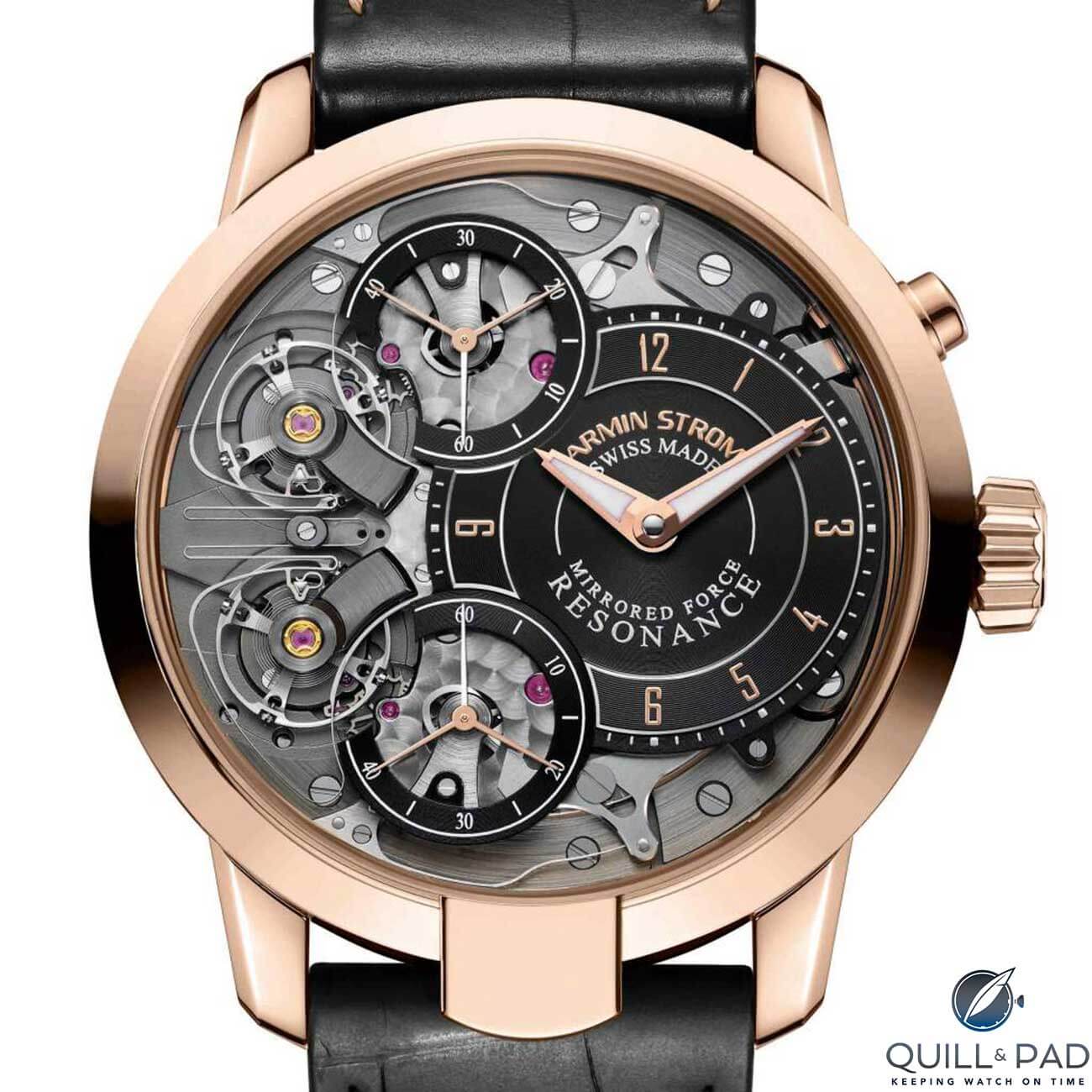
Armin Strom Pure Resonance Fire
TM: Few brands have changed as dramatically over the last decade as Armin Strom. Ten years ago, the brand was a low-profile specialist known exclusively for skeletonizing and engraving ETA calibers. Today, the firm offers a full range of manufacture products including the pre-selected Pure Resonance Rose Gold.
The Pure Resonance leverages eighteenth-century clockmaker Antide Janvier’s resonance phenomenon in a wristwatch format, and that remains a rarity. There have been some reservations about the coupling spring employed by the brand’s engineers (i.e., “that’s not a true resonance” according to one fellow who’s, um, known for this kind of thing). More to the point for watch collectors, the Armin Strom solution synchronizes the balances and works beyond a doubt.
Nevertheless, the purity of this watch’s resonance credentials matter less than its ubiquity in each new Armin Strom rollout since 2015. As with most other contenders in the Chronometry category, the Pure Resonance Rose Gold is not new in any sense that would warrant an award.
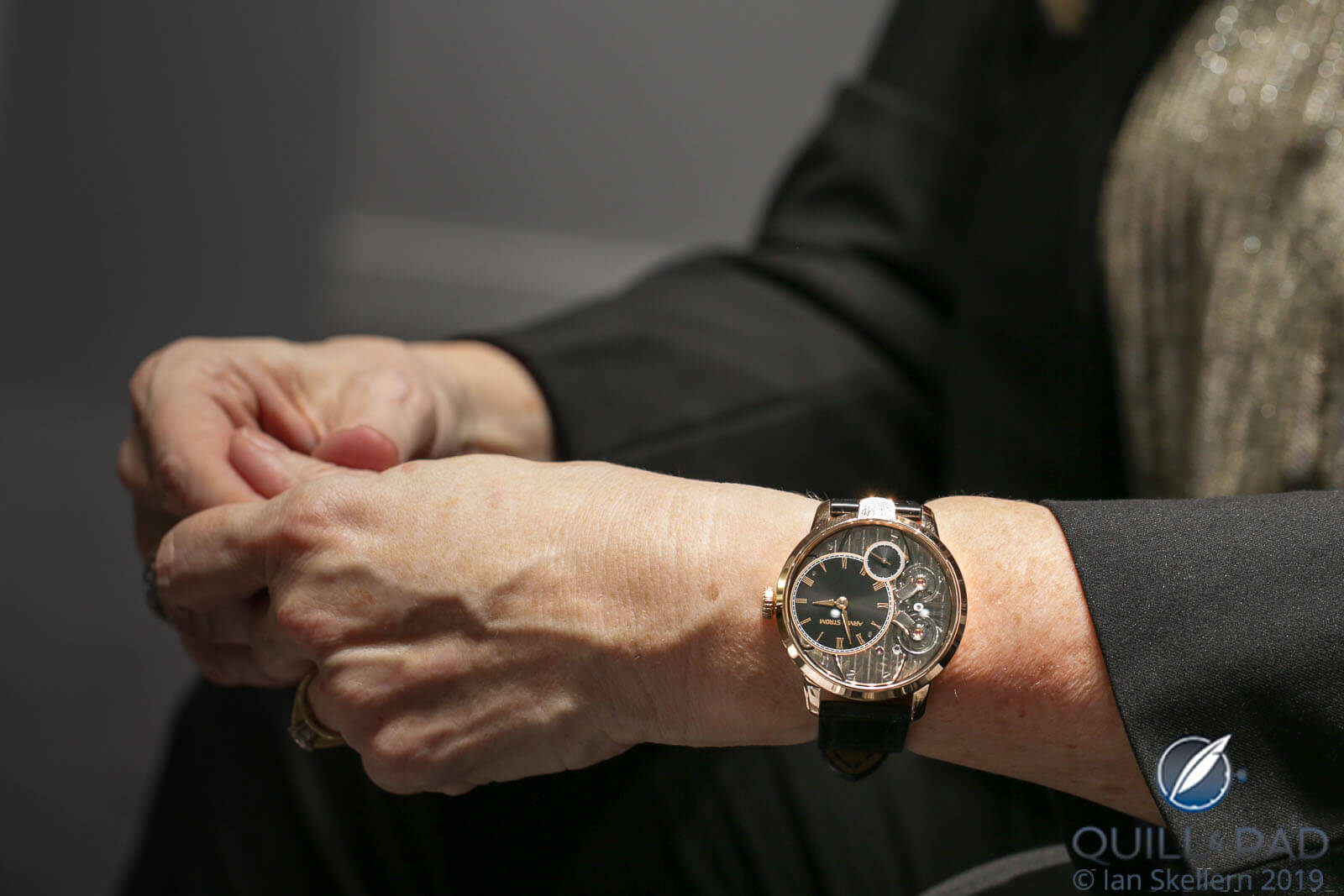
Armin Strom Pure Resonance Fire on the wrist
JM: This might be the hardest watch to not even nominate in my top three because resonance is, and will probably remain, a huge rarity in the watch industry. Armin Strom has created an amazing system that even visually demonstrates the commonly misunderstood principle of resonance and has successfully fitted it into a growing variety of executions. One problem for me is that, due to its construction and current rate-timing techniques, the actual effective rate cannot be conclusively determined (meaning no chronometer rating). Another is that this wasn’t just released but is a later iteration of something developed a couple of years ago. Those combine to make it hard to pick for the top spot in this category, even if it is a ridiculously amazing watch!
IS: It’s worth noting, Tim and Joshua, that the Pure Resonance movement is new (2018) and not a tweak or update to its processors in that the two movements within are stacked vertically rather than side by side as in the original models. That makes for a completely different movement rather than modifications to an existing caliber.
While I don’t think that the Pure Resonance Rose Gold will be the jury’s first pick, it is mine because the patented dual resonant regulators are innovative in the quest for better precision and the movement is recent. But what gives it the overall edge over the Zenith Defy Inventor for me is that the Pure Resonance looks better (subjective, I know), is more legible (what’s the use of higher precision if you cannot easily read the indications?), and more wearable (42 mm versus 44 mm for the Inventor).
Further reading:
On The Wrist: Armin Strom Pure Resonance
Armin Strom Pure Resonance: Less Really Is More And That Resonates
For more information, please visit gphg.org/horlogerie/en/watches/pure-resonance-rose-gold.
Quick Facts Armin Strom Pure Resonance Rose Gold
Case: 42 x 12 mm, pink gold
Movement: manual winding Caliber ARF16 with visible resonance clutch spring, two independent, symmetrically mirrored regulators beating at 25,200 vph / 3.5 Hz frequency
Functions: hours, minutes, seconds
Price: 62,000 Swiss francs
Chronométrie Ferdinand Berthoud Carburized Steel Regulator
SL: I’m not personally a big fan of regulator displays; I find them awkward to read the time. I do admire though how this Ferdinand Berthoud timepiece makes no excuses about its raison d’être, which is to put the very essence of chronometry in the classical horological sense to the fore, with the central second hand taking pride of place on the dial. Fusée and chain movements are also always impressive, something that only a handful of brands are tackling these days. It’s one of those watches I’d be tempted to wear back to front, just to see its movement.
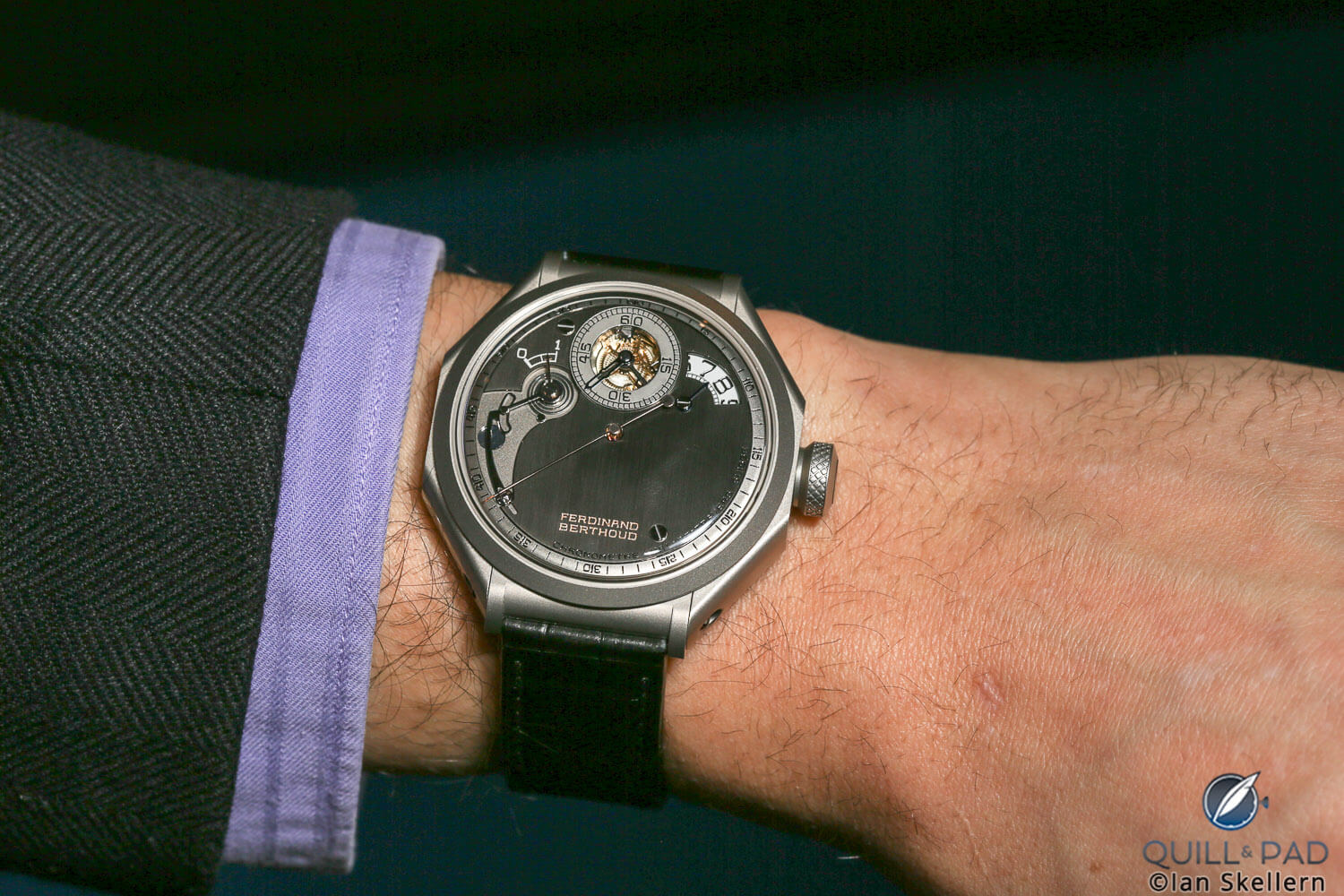
Ferdinand Berthoud Chronomètre FB 1R.6-1 on the wrist
IS: From the photos, I strongly disliked the case and dial design of Ferdinand Berthoud when the brand first launched with its FB1 late 2015. I just didn’t get it at all. Then a few months later, I had the opportunity to handle the watch and fell in love. I thought it a well-deserved winner of the GPHG Aiguille d’Or in 2016.
With its tourbillon, constant force fusee-and-chain, and regulator dial (ideal for the Chronometry category), in nearly any other year I’d be happy to select the Carburized Steel Regulator as my winner here; however, despite the modification to the movement to display hours on a separate disk to make it a regulator, I feel that there are a couple of newer high precision wristwatches in this category that have a stronger claim to first place. This is a watch I’d love to own and wear, though (price aside).

Chronométrie Ferdinand Berthoud Carburized Steel Regulator
JM: Pardon my French, but Ferdinand Berthoud makes some dope watches. Ever since I first saw one I was smitten, and the FB 1R.6-1 Regulator is no exception. The style of the movement is ultra-classic as it was designed to emulate early chronometers, and the execution is incredible. It is C.O.S.C.-certified, which means we know it achieves the baseline of awesome for chronometry, though it achieves it with generally established technology and engineering.
Don’t get me wrong, this piece is drool-worthy and a definite contender, but I fear it hasn’t made enough advances to take the top spot.
TM: Chronométrie Ferdinand Berthoud has had a strong run at the GPHG since winning the Aiguille d’Or in 2016. That said, each new product of the Chopard apex brand has been a variation on the original FB1 whose superb finish, exemplary ergonomics, and impressive technical accomplishment have aged well. Each new iteration of the watch underscores the appeal of the basic design. That said, we’re talking about a variation on a four-year-old design.
Further reading:
Ferdinand Berthoud Chronomètre FB 1R.6-1: Distinctly Different, Technically Superlative (And Videos)
Ferdinand Berthoud Is Reborn With FB 1 Thanks To Chopard’s Karl-Friedrich Scheufele
Who Was Ferdinand Berthoud And Why Should We Care?
For more information, please visit gphg.org/horlogerie/en/watches/carburised-steel-regulator.
Quick Facts Chronométrie Ferdinand Berthoud Carburized Steel Regulator
Case: 44 x 13.95 mm, carburized steel
Movement: manufacture Caliber FB-T.FC.R, with chain and fusée and one-minute tourbillon, power reserve 53 hours, 3 Hz/21,600 vph frequency
Functions: hours, minutes, direct-drive second hand from tourbillon; power reserve indicator
Limitation: 20 pieces
Price: $241,500/230,000 Swiss francs
IWC Schaffhausen Big Pilot’s Watch Constant-Force Tourbillon Edition Le Petit Prince
IS: François-Paul Journe once told me that he thought adding a tourbillon to a precision movement was the equivalent of breaking your leg before a race and that then adding constant force was like adding a splint to the break: an improvement certainly, but better not to break your leg in the first place.
Whether that’s true or not (and Greubel Forsey and many others certainly disagree), the IWC Big Pilot’s Watch Constant-Force Tourbillon Edition Le Petit Prince is a great looking watch. And I’ve no doubt that its constant force mechanism makes it (potentially at least) a very accurate watch, but I don’t think it’s strong enough to take the prize here.
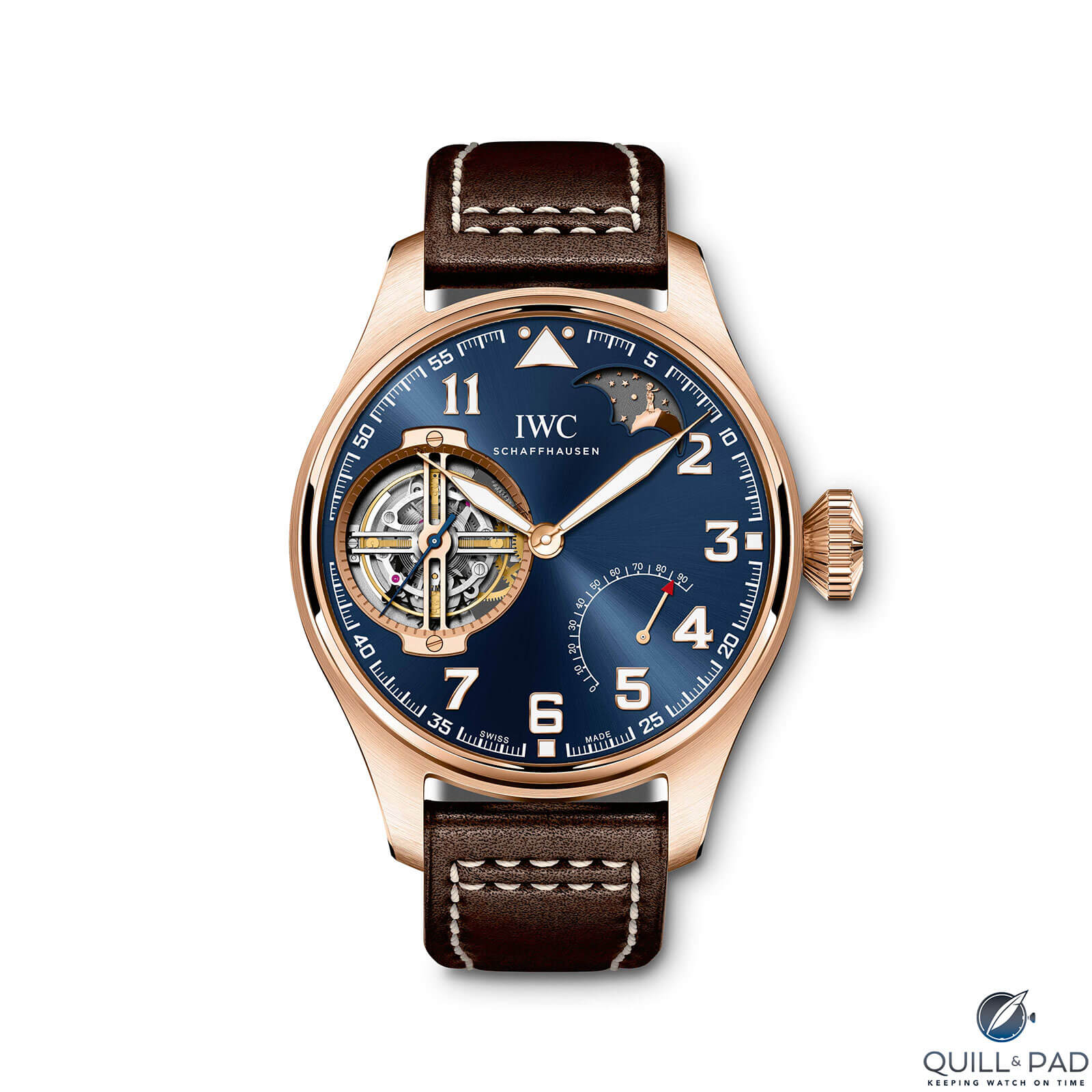
IWC Big Pilot’s Watch Constant Force Tourbillon Edition Le Petit Prince
I’d also like to point out that I’m constantly surprised by the lack of thought and effort that many, if not most, brands, put into their explanation texts when entering the GPHG. Quite often the information supplied is generic rather than specific and/or emphasis is placed on the wrong features.
Despite being entered in the Chronometry category, the first half of IWC’s text focuses on the special hard gold of the case rather than the watches’ chronometric strengths, meaning its tourbillon and constant force mechanism. And is that patented constant force mechanism a remontoir d’égalité (I guess so) or something else? It would have been nice to know more about it for this category.
SL: As much as I like the brand (I have some IWCs in my collection that have a lot of sentimental value), I’m not too keen on a tourbillon in a pilot’s watch. IWC’s own constant-force tourbillon is certainly an interesting technical achievement, I just prefer to see it in a Portugieser or a more classical presentation (which IWC does have), rather than in the Big Pilot.
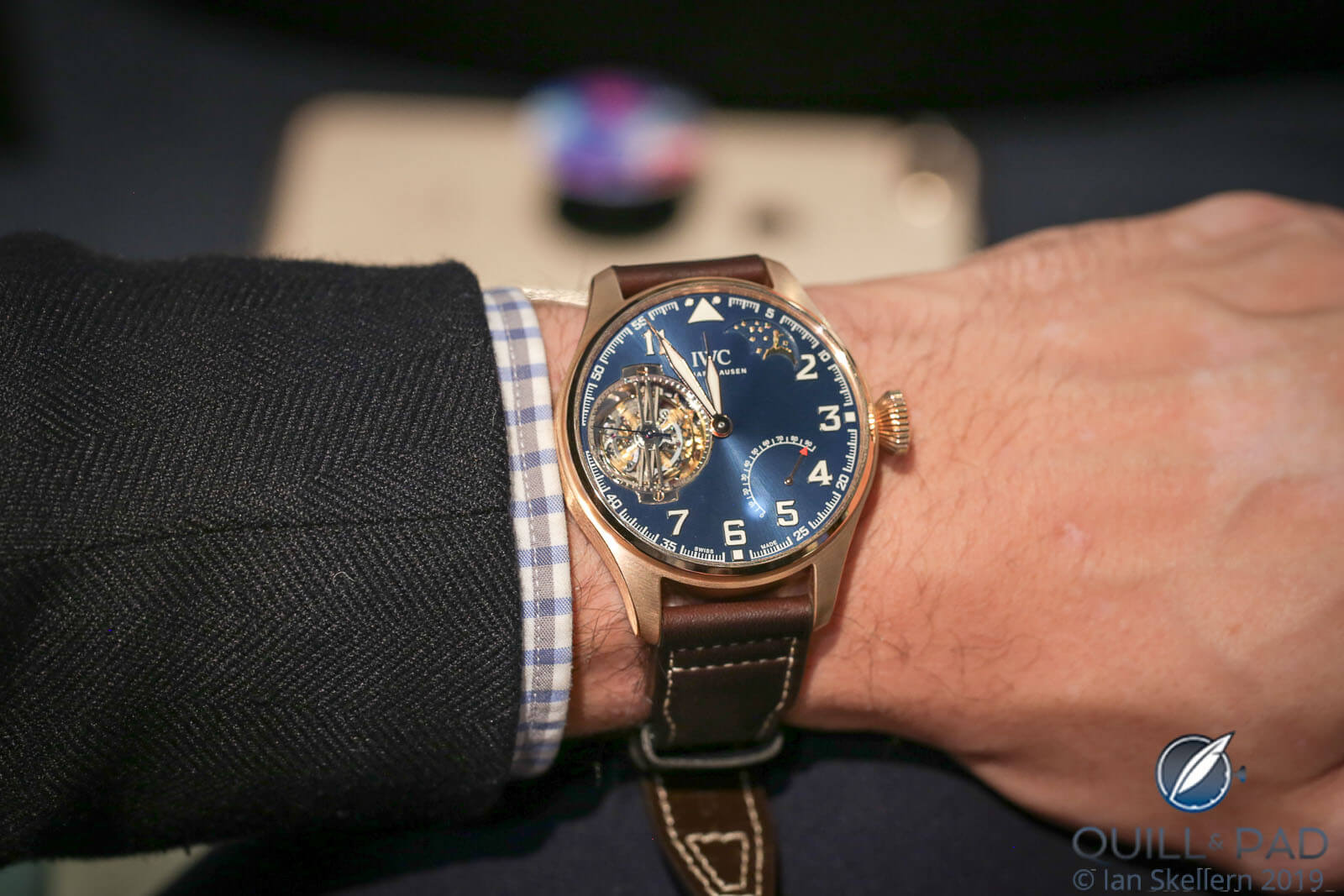
IWC Schaffhausen Big Pilot’s Watch Constant-Force Tourbillon Edition Le Petit Prince
TM: IWC’s Big Pilot’s Watch Constant Force Tourbillon Edition Le Petit Prince is a huge watch with a huge name to match.
Technically, this is an accomplished addition to the growing population of constant force/tourbillon tandems. Along with A. Lange & Söhne, Ferdinand Berthoud, Breguet, Zenith, F.P. Journe and others, IWC has put its mark on the genre courtesy of the brand-defining Big Pilot shape.
That said, we’ve seen this Caliber 94805 in identical specification on IWC’s 2013 Ingenieur Constant Force and 2017’s Portugieser Constant Force. Alternatively, this Big Pilot could be viewed as a stripped-down Portugieser Sidérale Scafusia. Pass.
JM: I feel like IWC misses the mark this year with how it entered its pieces, and this is another example. The Big Pilot’s Watch Constant-Force Tourbillon is an awesome watch with a very cool constant force tourbillon mechanism, but little to no information about how accurate it is aside from claiming that it has an “extraordinarily high level of precision.”
Cool, good for you, but it doesn’t mean a thing without numbers. It may very well be chronometer grade (but why hide that?) or provide extremely stable rates over time, even if it falls outside of chronometer limits (consistency is often more valuable over time than accuracy). But with no information, I can only assume it is only as accurate as any other watch, and the innovation inside is more show than go.
Heck, the brand even makes sure to call out the accuracy of the moon phase (577.5 years, good enough to earn honorable mentions on my list of most accurate moon phases) and says nothing of the rate of the watch. Can’t be a winner when you don’t have any numbers to share.
For more information, please visit gphg.org/horlogerie/en/watches/big-pilots-watch-constant-force-tourbillon-edition-le-petit-prince.
Quick Facts IWC Schaffhausen Big Pilot’s Watch Constant-Force Tourbillon Edition Le Petit Prince
Case: 46.2 x 13.5 mm, red gold
Movement: manual winding Caliber 94805 with one-minute tourbillon and constant force, 2.5 Hz/18,000 vph frequency, power reserve 96 hours, twin spring barrels
Functions: hours, minutes, seconds; power reserve display, moon phase
Limitation: 10 pieces
Price: 235,000 Swiss francs
TAG Heuer Autavia Isograph
JM: For my runner-up, I have to go with the TAG Heuer Autavia Isograph as it introduces a groundbreaking new material in a watch priced for the average collector. Being the second watch from TAG Heuer bearing the brand-new carbon composite hairspring based on carbon nanotubes and amorphous carbon – the first being the Calibre Heuer 02T Tourbillon Nanograph – it is the best choice for entry in this category.
Not only does the watch play to a broad demographic aesthetically, it achieves C.O.S.C. chronometer certification with the most high-tech hairspring in the industry. It is a fantastic piece with industry-altering technology at a price that probably surprised everyone. The only reason I can’t choose it for the number one position is that my winner doesn’t even need a hairspring to achieve chronometer certification.
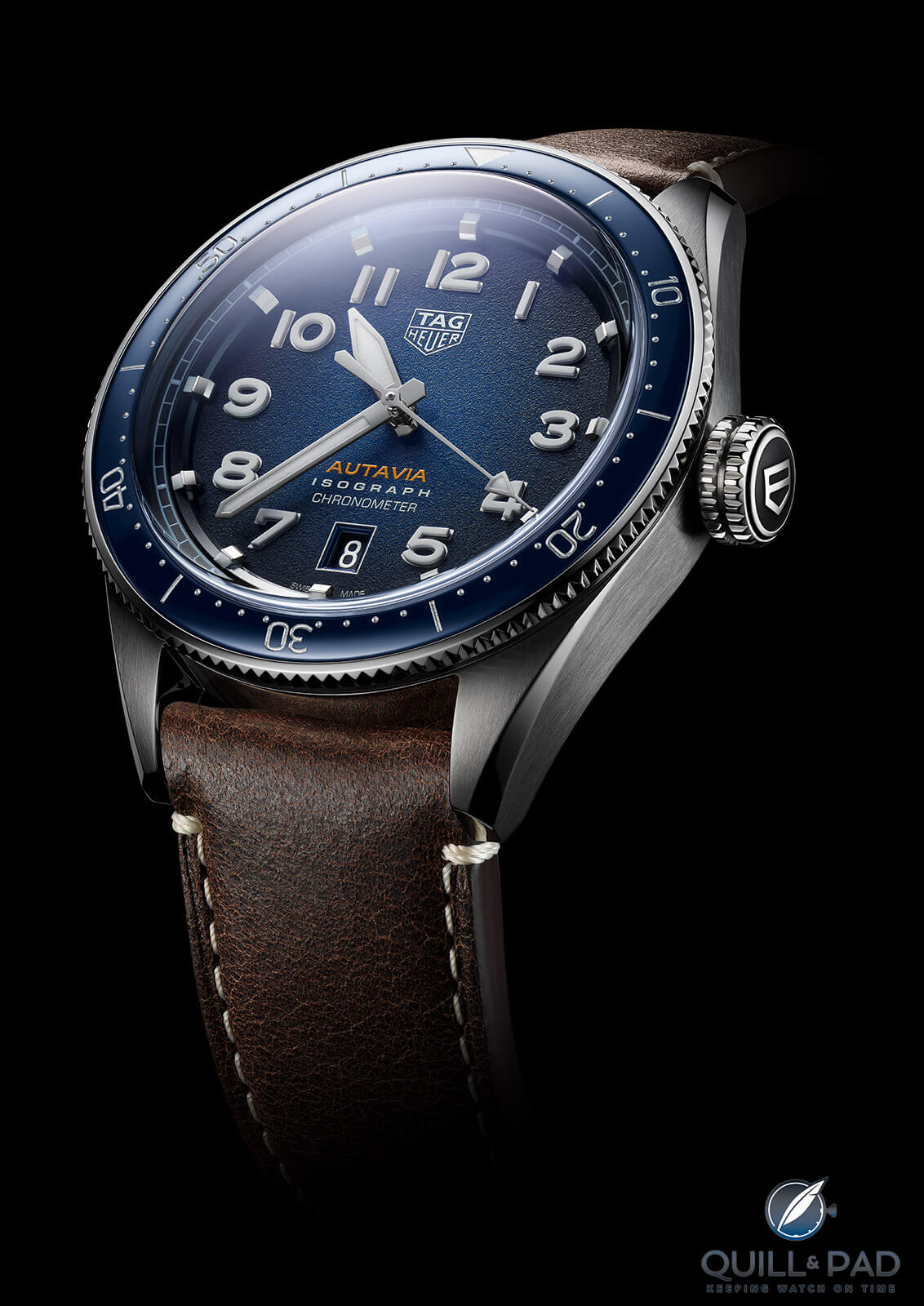
TAG Heuer Autavia Isograph
TM: Ultimately, TAG Heuer deserves to be recognized for its Autavia Isograph. This watch lacks the sheer spectacle and grandeur of the other five pre-selections, but only TAG Heuer can claim to offer something truly new for the industry: a carbon-composite hairspring. While Zenith promised to launch this technology on the Defy El Primero 21, sharp-eyed enthusiasts are aware that the production model employs a conventional metallic flat hairspring.
TAG Heuer’s new Autavia Isograph is a triumph on several levels.
First, manufacturing a hairspring is a big deal. During Swiss government mediation of the Swatch Group customer-component drawdown, Nivarox, Swatch Group’s hairspring source, was the focus of far more Competition Commission scrutiny than ETA, the movement source. Hairsprings are that much harder to make in volume, and viable alternatives to Nivarox were fewer than ETA’s rivals. Now TAG Heuer can make its own hairspring, and it owns the patents.
Second, the carbon hairspring is a technical red letter. An ideal hairspring design should beat concentrically like a Breguet overcoil, exhibit a low coefficient of thermal expansion, be immune to magnetic fields, be cost-effective to manufacture, and resist elastic deformation during service or installation. The new TAG Heuer carbon hairspring does all of the above.
Third, the new TAG Heuer hairspring arrives in a truly novel and appealing package. Unlike the other pre-selections in this category, the Autavia Isograph is an all-new product. It’s handsome, nicely sized, well priced, and the design honors history without devolving into another cloying “re-edition.” At 42 mm, the size is perfect for a modern sports watch, and the combination of timing bezel, generous lume, and 100-meter water rating offer immense practicality. Dial detail is superb, and the rich gradient fade looks stunning on the textured surface of this watch face.
Too often, watch technology follows the automotive path of “trickle down” from flagship models to the entry level. TAG Heuer has flipped the script with its new Autavia. The Isograph also could be the value-driven “Challenge” category champion for 2019. The least imposing and most conservative “Chronometry” pre-selection is the one with the best claim to innovation for this model year.
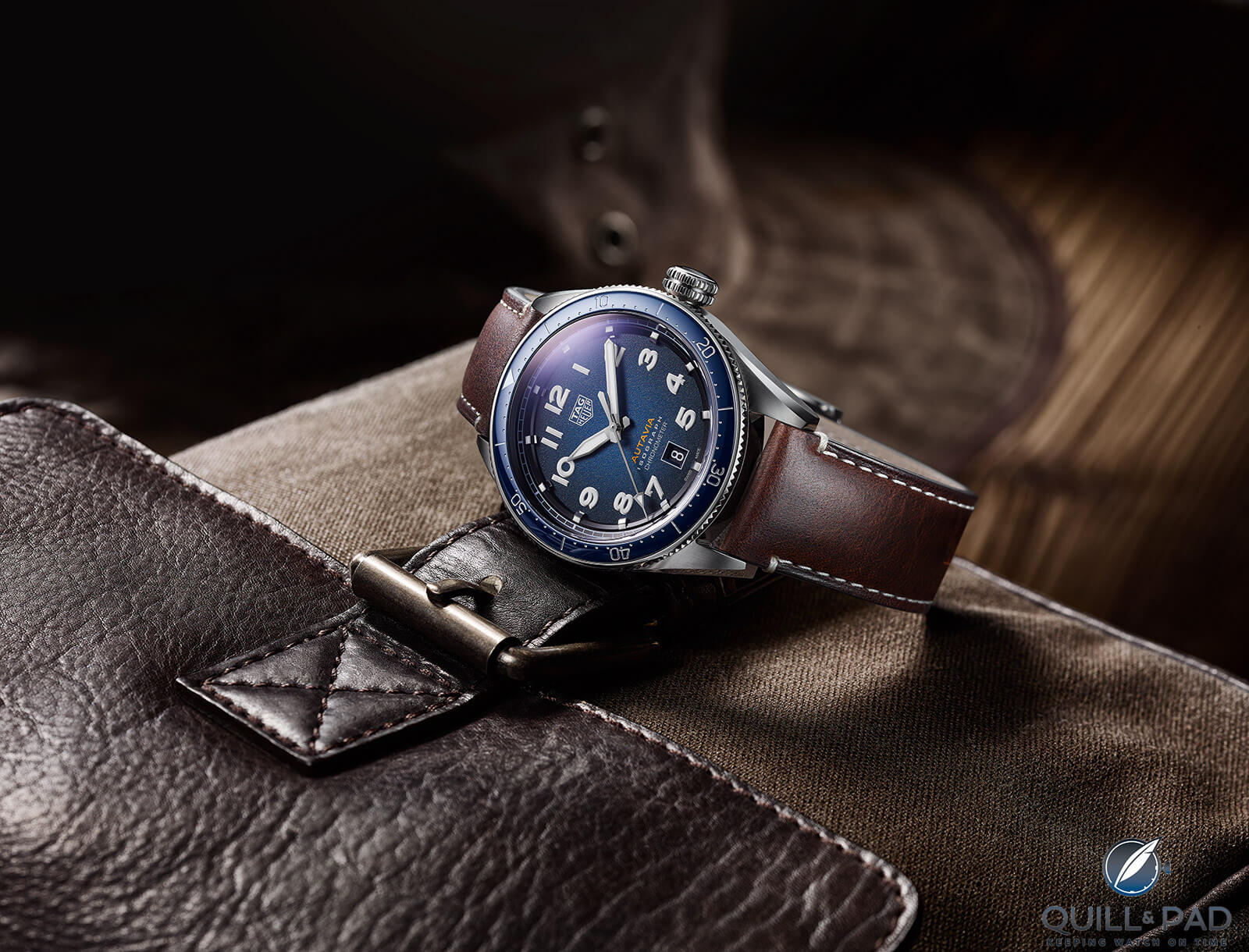
TAG Heuer Autavia Isograph
SL: I applaud the fact that TAG Heuer is bringing the carbon-composite hairspring to this new Autavia collection and not just reserving it for the haute horlogerie pieces designed to appeal to a niche collector. As a result, it’s probably one of the watches from this category that most closely ascribes to the spirit of it; I’m a strong proponent that fine watchmaking should apply to a wide range of watches and not only the high-end, highly complex pieces. It’s a rather subtle detail, though, one that requires a deep appreciation of chronometry itself and why it’s been such a challenge for mechanical watchmaking, really ever since its inception.
IS: The TAG Heuer Autavia Isograph is a fantastic daily wearer and at 42 mm it is the right size. Its price of 3,500 Swiss francs and U.S. dollars is sure to make it a big seller. But while it is chronometer certified and features a carbon-composite hairspring, I doubt that will be enough to win in this incredibly strong lineup.
MG: Visually, each and every watch in this category has something to offer, although the Autavia might be the plainest. Even that was on purpose as it was designed to appeal to a broader audience. That makes its technology all the more impressive: it is one thing to innovate, yet another to repeat that on a large scale. So if pressed on choosing a winner here, I have to go with the Autavia.
Further reading:
TAG Heuer Autavia Isograph: Carbon-Composite High-Tech Hairspring For All
For more information, please visit gphg.org/horlogerie/en/watches/autavia-isograph.
Quick Facts TAG Heuer Autavia Isograph
Case: 42 x 13.43 mm, stainless steel
Movement: automatic Caliber 5 with Isograph carbon-composite hairspring, officially chronometer certified, 4 Hz/28,800 vph frequency, 38-hour power reserve
Functions: hours, minutes, seconds; date
Price: $3,500/3,500 Swiss francs
Zenith Defy Inventor
SL: This is also an impressive development coming out of Guy Sémon’s LVMH watchmaking skunkworks. Even farther reaching than the carbon composite hairspring used in the TAG Heuer Autavia Isograph, it’s fundamentally re-organizing how the timekeeping functions are constructed. So it’s definitely a strong contender in this category. I’d like to see it fitted to other, perhaps more classical collections in the near future; while it’s exciting as a proof-of-concept to see the Zenith Oscillator at work through the skeleton dial, I find it a little distracting given its high frequency.
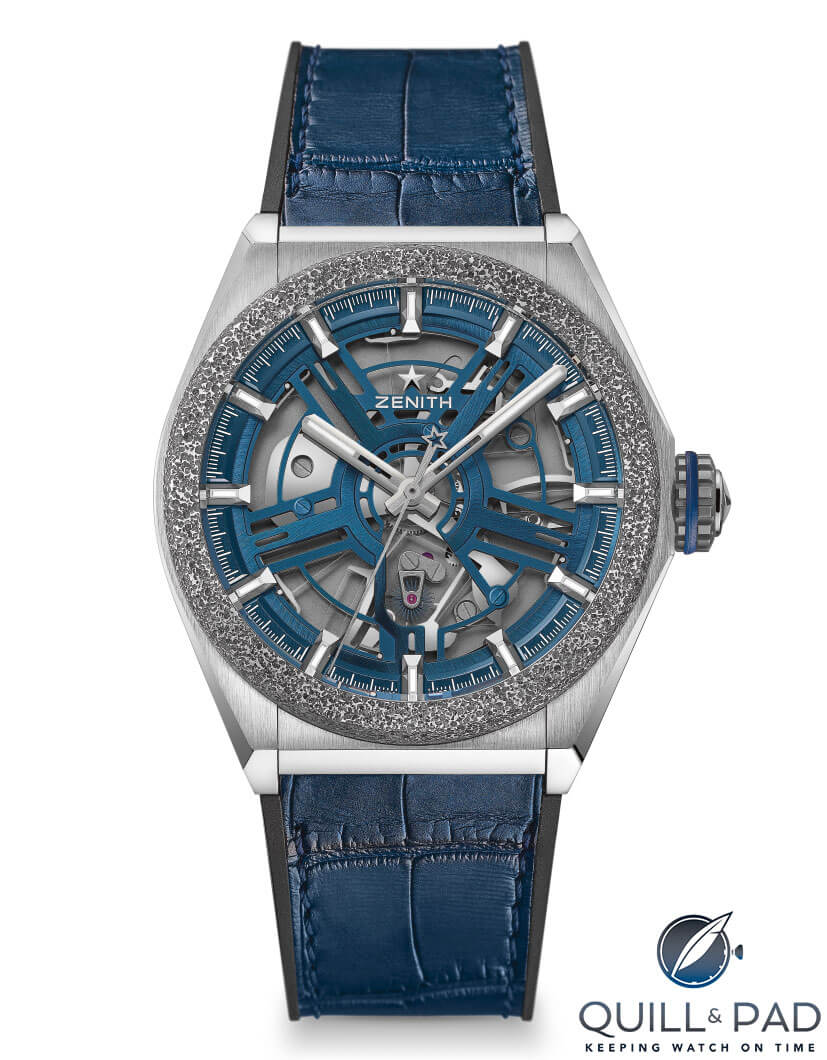
Zenith Defy Inventor
JM: While the silicon making up the oscillator in the Zenith Defy Inventor may not be as brand-spanking new as the carbon composite of the TAG Heuer Autavia Isograph, it is even more complicated for what it does. Unlike traditional components made in new materials, the oscillator of the Defy Inventor creates new engineering with relatively new materials to accomplish a dramatic feat of precision all while eliminating the traditional hairspring. This oscillator comprises both the balance and the spring in one solid piece of silicon that vibrates at an extremely rapid 18 Hz (129,600 vph). This meshes with an escape wheel with flexible teeth (also solid silicon) for a dazzling display of hyperactivity that is chronometer certified by Timelab as well as being antimagnetic and insensitive to temperature.
It also is featured in a rather interesting case bearing the original Defy Lab’s aluminum foam material Aeronith as a bezel, providing a touch of material science that is appreciated from my point of view. This category is a tough call, but I think the Defy Inventor is the most innovative of the bunch, even if another watch also has a newly invented material inside.
TM: Zenith’s Defy Lab was a revelation in 2017. The resonating silicon drive system embodied a first for the industry, and the benefits are obvious: mechanical takes a step closer to quartz precision; low amplitude and high frequency yield a surprising power reserve; extensive use of synthetic components reduces the need for maintenance-intensive lubrication. The technology is somewhat soulless – most core components are of industrial fabrication – but it represents engineering innovation consistent with the spirit of the “Chronometry” prize.
While others including Vaucher and De Bethune had discussed such a technology on a theoretical level, Zenith and LVMH (there was significant TAG Heuer input) delivered ten first-run examples to clients before announcing general production in 2019. If Zenith hadn’t already won the 2017 Innovation prize for the pre-production Defy Lab, there would be no denying a Chronometry category win for the new Defy Inventor.
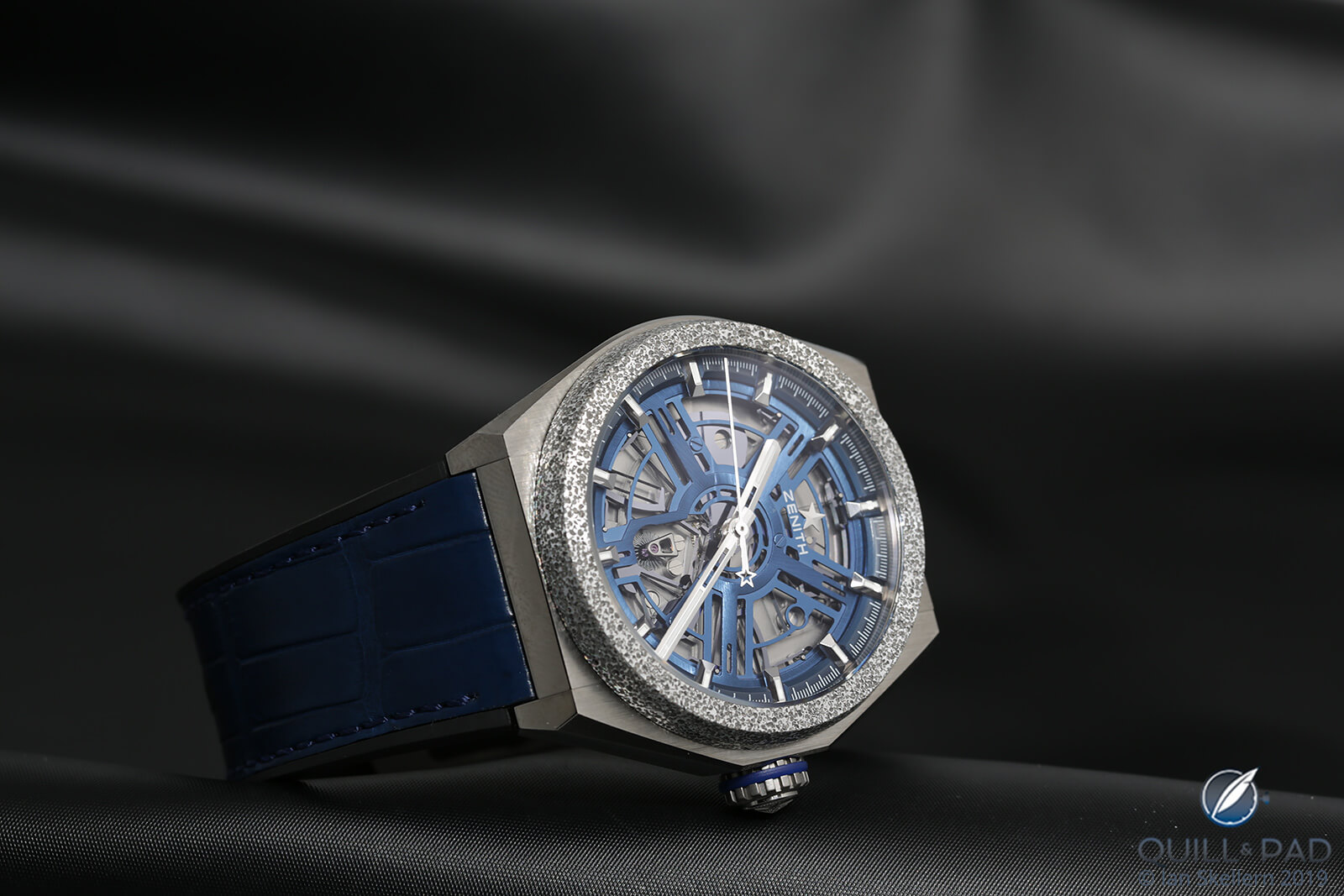
Zenith Defy Inventor
IS: The Chronometry category is all about precision and the precision of any timepiece is dictated by its regulator, which usually features a Swiss lever escapement invented by British clockmaker Thomas Mudge in 1755 that the vast majority of brands tweak and/or add additional mechanisms to such as a tourbillon or constant force escapement if they want more accuracy (or marketing kudos) than the standard escapement can provide.
I like rewarding recent innovation in these GPHG predictions, and in terms of innovation alone the Defy Inventor has this category sewn up by replacing the complete Swiss lever regulator and its around 30 parts with just one silicon component, the patented Zenith Oscillator, beating at 18 Hz, which is more than four times faster than the typical oscillator. And all else being equal, speed = precision.
The only reason I’m not picking the Defy Inventor as the winner of this category (though I suspect a few of my colleagues will) is that while it leads the field for me in recent innovation, and particularly chronometric innovation, I’m just not won over visually by the rest of the watch, particularly the Aeronith (aluminum-polymer composite) bezel and skeletonized dial: I’m not enamored by the look of the former and the dial makes it difficult to see/make use of the precision offered by the movement.
While looks aren’t everything, especially in the Chronometry category they are important, and the Defy Inventor just doesn’t work for me visually. And as we mentioned in the introductions, this category isn’t judged objectively by precision alone – if at all, as there is zero information about accuracy for any of the pre-selected watches here. While the Defy Inventor isn’t my personal pick for this category, I think that it will be the jury’s choice and that’s what matters most.
Further reading:
Zenith Defy Inventor: Experimental Compliant Tech Goes Into Serial Watch Production
The Zenith Defy Lab Highlights Technology That Could Change Future Watchmaking
For more information, please visit gphg.org/horlogerie/en/watches/defy-inventor.
Quick Facts Zenith Defy Inventor
Case: 44 x 14.5 mm, titanium with Aeronith bezel
Movement: automatic Zenith Caliber ZO 9100 with monolithic silicon oscillator; 32.8 mm diameter; 148 components including 18 jewels; 18 Hz/129,600 vph frequency, power reserve 50 hours
Functions: hours, minutes, hacking seconds
Price: 18,900 Swiss francs
Predicted Winners
Martin: TAG Heuer Autavia Isograph
Tim: TAG Heuer Autavia Isograph
Sean: Zenith Defy Inventor
Joshua: Zenith Defy Inventor
Ian: Zenith Defy Inventor
You may also enjoy:
Our Predictions In The Ladies Category Of The 2019 Grand Prix d’Horlogerie de Genève (GPHG)
Leave a Reply
Want to join the discussion?Feel free to contribute!





















































I picked the Berthoud for this one, but am happy the Zenith gets the most plaudits here*.
*It’s got NOTHING to do with the fact I bought a Zenith the other day.
Correction: I decided to return the Zenith, and got something else for a little bit extra, so your picks are all wrong. Elizabeth, you’ll never guess what I got, seems I was too quick to judge…
An A. Lange & Söhne Richard Lange Jumping Seconds?
God I wish. That slightly deflates my balloon. *air escapes with a funny noise*
No, a Reverso.
Sorry, I was pulling a guess out of the air. Reversos are amazing, and I truly wish I had one!!
My vote would go to zenith but the defy lab won a few years back and I fear that the final result might be less exciting than awarding the zenith which totally deserves it in my opinion